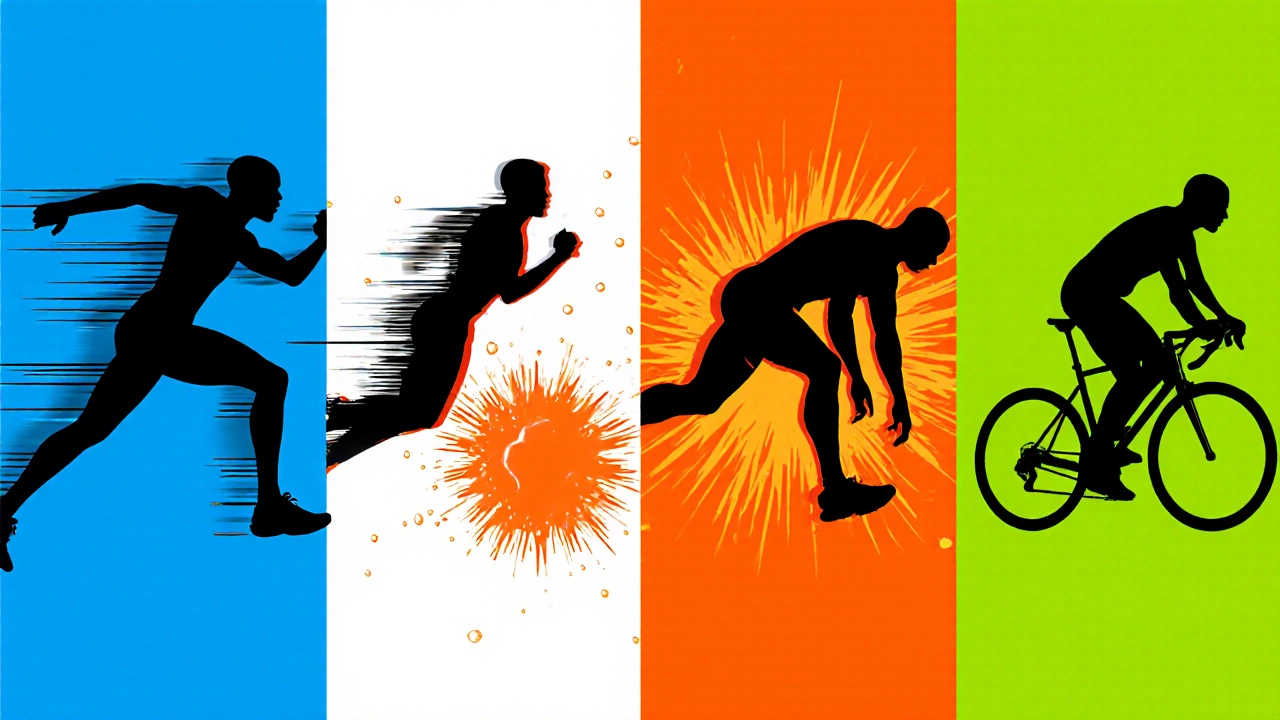Plank Duration Calculator
Progress Tracker
Everyone scrolling through fitness feeds wonders if a single move can melt stubborn belly fat. The short answer? Yes - the best exercise for belly fat is the plank, but only when you pair it with the right intensity, frequency, and supporting habits.
Why Belly Fat Is Tricky and How Exercise Helps
Before diving into the plank, it’s worth knowing what you’re actually fighting. Visceral Fat is the deep‑lying fat that wraps around your organs. It’s metabolically active, meaning it releases hormones that make losing weight harder. Unlike sub‑cutaneous fat, visceral fat responds well to a mix of calorie deficit, cardio, and strength work that spikes the heart rate.
When you move, your body taps into stored energy. High‑intensity moves raise the Resting Metabolic Rate, so you keep burning calories even after you finish the workout. That’s why an exercise that recruits multiple muscle groups and elevates heart rate is more effective than isolated crunches alone.
The Plank: Definition, Benefits, and Core Muscles Engaged
Plank is a body‑weight hold where you keep a straight line from head to heels while supporting yourself on forearms and toes. It targets the Core Muscles - the transverse abdominis, rectus abdominis, obliques, and lower back - all of which act like a corset around the midsection.
Benefits go beyond a flat stomach:
- Improves posture, which in turn makes the waist look slimmer.
- Boosts overall strength without the need for equipment.
- Raises heart rate when done in intervals, turning a static move into a calorie‑torching session.
Because the plank is an isometric exercise, it builds endurance in the musculature that supports daily activities - from lifting groceries to sitting at a desk all day.
How to Perform the Plank Perfectly
- Start on all fours. Place forearms on the ground, elbows directly under shoulders.
- Extend your legs behind you, balancing on the balls of your feet. Keep hips neither sagging nor piking.
- Engage the core: imagine pulling your belly button toward your spine.
- Hold for 20‑30 seconds if you’re a beginner; work up to 60‑90 seconds for advanced levels.
- Maintain steady breathing. Exhale on any slight adjustment, inhale to reset.
Common mistakes to avoid:
- Hips dropping - this reduces core activation and stresses the lower back.
- Holding the breath - it spikes blood pressure without added benefit.
- Rushing the hold - quality beats quantity every time.

Boosting the Plank with High‑Intensity Interval Training (HIIT)
To transform the static plank into a belly‑fat‑blasting engine, embed it in a High‑Intensity Interval Training (HIIT) circuit. HIIT alternates short bursts of maximal effort with brief recovery periods, keeping the metabolism revved for up to 48 hours post‑workout.
Sample 15‑minute HIIT circuit:
- 30 seconds of jumping jacks (cardio warm‑up).
- 30 seconds of plank hold.
- 15 seconds rest.
- 30 seconds of burpees (see below).
- 30 seconds of bicycle crunches (see below).
- 15 seconds rest.
- Repeat the sequence 3‑4 times.
This format keeps heart rate in the fat‑burning zone while the core stays under tension.
Two Companion Moves That Pair Perfectly with the Plank
While the plank is the star, adding dynamic core work maximizes muscle fiber recruitment.
Bicycle Crunches mimic the pedaling motion, targeting the obliques and rectus abdominis with a rotational component. Perform 12‑15 reps per side, focusing on slow, controlled movement.
Burpees combine a squat, plank, and jump. They spike the heart rate, burn calories, and still activate the core during the plank segment. Aim for 8‑10 reps per round.
Comparison of the Top Belly‑Fat‑Burning Moves
| Exercise | Primary Muscle Target | Avg Calories Burned (per 5min) | Difficulty | Equipment Needed |
|---|---|---|---|---|
| Plank | Core (all layers) | ≈ 30‑40 kcal | Beginner‑Advanced (time‑based) | None |
| Bicycle Crunches | Obliques & rectus abdominis | ≈ 45‑55 kcal | Intermediate | None |
| Burpees | Full‑body (core, legs, chest) | ≈ 70‑85 kcal | Advanced | None |
| HIIT (mixed) | Varies (depends on chosen moves) | ≈ 80‑100 kcal | Advanced | Minimal (space for jumps) |
Creating a Weekly Belly‑Fat‑Blasting Routine
Consistency wins over intensity, but pairing both is ideal. Here’s a 4‑day plan that slots the plank at the center of each session:
- Monday - Core HIIT: 15‑min circuit (plank, burpees, bicycle crunches). Finish with a 60‑second static plank.
- Tuesday - Light Cardio + Stretch: 30min brisk walk or jog, followed by 5‑minute standing hip flexor stretch.
- Thursday - Strength + Core: Upper‑body dumbbell circuit (push‑ups, rows) + plank variations (side plank, forearm to straight‑arm).
- Saturday - Full‑Body HIIT: 20‑min interval (jump squats, mountain climbers, plank, rest). End with 2×45‑second planks.
Leave at least one rest day between core‑heavy sessions to allow muscle recovery. Pair the routine with a modest Calorie Deficit of 300‑500 kcal per day, and you’ll see waistline reductions in 4‑6 weeks.
Common Pitfalls and How to Dodge Them
- Focusing only on crunches. Isolated ab work burns few calories; the plank’s full‑body tension makes a bigger impact.
- Neglecting nutrition. No amount of planking can outrun a diet high in refined carbs. Aim for protein‑rich meals and fiber.
- Skipping progressive overload. Increase plank hold time, add weight on the back, or transition to side planks as you improve.
- Doing planks daily without rest. Muscles need 48‑72hours to repair and grow stronger.
Tracking Progress Without the Scale
Because belly fat is stubborn, weight can stay flat while you lose inches. Use these metrics:
- Waist circumference: measure at the navel, once a week.
- Body‑fat percentage: handheld calipers or smart scales give a clearer picture.
- Plank endurance: note how long you can hold with perfect form - a 30‑second gain often equals visible tightening.
When to Seek Professional Guidance
If you have existing back issues, pregnancy, or cardiovascular concerns, consult a physiotherapist or certified trainer before launching an intensive plank‑centric program. They can tailor the movement to your specific needs, ensuring safety and effectiveness.
Frequently Asked Questions
Can I lose belly fat by doing only planks?
Planks are excellent for strengthening the core, but belly fat is primarily reduced through a calorie deficit and cardio. Combining planks with HIIT or steady‑state cardio maximizes results.
How long should a plank hold be for fat loss?
Start with 20‑30 seconds and aim to build up to 60‑90 seconds. The key is maintaining perfect form; once you can hold that time, add variations or weight for continued challenge.
What’s the difference between abdominal crunches and planks?
Crunches involve repeated spinal flexion, which mainly targets the rectus abdominis. Planks are isometric, engaging the entire core stack and also improving shoulder and glute stability.
Is there a risk of lower‑back injury with planks?
Yes, if the hips sag or the neck is let down. Keep a straight line, engage the glutes, and avoid holding your breath. If you feel strain, shorten the hold and work on form first.
How often should I train my core each week?
Two to three focused sessions, each with 3‑5 minutes of total plank time (including variations), are sufficient. Spread them out to allow recovery.





